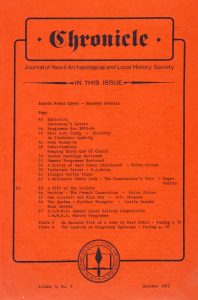1985-Oct-pg61-62_A Mediaeval Table Tomb – The Conservator’s Tale
This article came from the Chronicle published October 1985. Pages 61 – 62
A MEDIAEVAL TABLE TOMB – THE CONSERVATOR’S TALE
Author: Roger Harris
In North Cadbury Church, placed in the South West corner of the tower is the monument to Lord and Lady Bottreaux, founders of the present church. The monument is thought to date from 1391 and takes the form of a table tomb on which rest two effigies.
The tomb chest, which is delicately carved with weepers beneath a foliage frieze, was suffering badly from the destructive action of salts carried into the stone by rising damp. The salts crystallise at the surface, exerting pressure on the individual stone particles, causing the stone to ‘fail’ and fall away as dust. The only sure way of halting the decay is to extract the greater proportion of the salt, immobilise what remains by chemical means, and prevent more salts being introduced into the stone by the insertion of a lead damp proof course. This entails complete dismantling of the tomb. It was assumed that the job of dismantling would be fairly straightforward, but it is amazing how wrong one can be!
Between the West wall and the effigies, resting on the table top was a curious vaulted ‘canopy’. This did not seem to fit the monument and was thought to have been part, of something else. Monuments will often lose or gain bits and pieces throughout their life, and this canopy seemed to be a definite gain. The stone was in three pieces and easily removed. As the initial piece was lifted out, we were presented with the first of many pleasant surprises. The back face, which rested against the West wall, and had been assumed to be plain, was in fact carved to show six recessed panels flanked by roses, and all beautifully painted.
With the canopy removed we could see for the first time, the table top moulding along the concealed end, and that too was painted, a deep rich red. The question which sprung immediately to mind was whether a concealed end panel lay beneath the moulding. At this point, we were shown a document which confirmed that the monument had in fact been moved, in the late 18th or early 19th century, from the chancel steps, where it would have been visible on three sides.
The next stage was to remove the effigies, which in turn offered some surprises. Once removed, we found that the amount of detail on the side of the effigies facing the wall, indicated they would originally have been placed with that side facing outwards. Lord Bottreaux would have occupied the outer position. The reverse is the case now, he lies with the decorated side of the slab on which he rests pushed up against the south wall of the tower.
Once the effigies had been safely transported to the workshop at Wells, it was time to tackle the table top stones. The two stones at the eastern end were lifted without revealing any concealed detail -but when the first of those at the western end was raised, we were presented with a staggering sight. The mouldings on the underside were painted in black, white and blue, with shades of yellow and green and here and there, flourishes in purple and white. The small section of carved foliage which survives is even more impressive, freely painted in reds, greens and yellow, with the paint surviving virtually intact over the whole surface.
Now at last we had the first real glimpse of the concealed end panel. Although not as richly carved as the eastern end, the original paint survived over much of the surface, and this presented a problem. The paint, which was cracked and flaky, had adhering to the surface, a coating of soil particles. Any attempt to merely brush them away would result in the loss of much of the paint. The only solution was to consolidate everything first, dirt as well as paint, and then use a combination of solvent and mechanical cleaning to gently lift away the dirt. The panel had been carved with an arcade of three trefoil headed niches. The mouldings were painted in red, white and green, each bordering a painted shield on a blue background. The shields are quartered, each with a different combination of gryphons, vine leaves, and broad black diagonal bands. Later, as cleaning progressed, it became apparent that not only was the decoration, much richer than was at first thought, but some attempt at cost cutting had been made. The consolidant used has the effect of enhancing the colour of the decayed paint to something close to its original brilliance. As this was applied to the red mouldings, a series of small gold flowers appeared, but only on the mouldings in plain view, those facing the wall had no gilded flowers and no red paint, both costly items in 1391.
Once dismantled, the monument offered up othersecrets. The undercutting of the foliage frieze, which at first glance would seem to be the product of an exceedingly patient carver nibbling away behind the carved design with a chisel, was in fact achieved by cutting a hole along the back with an early type of core drill. The last find was a re-used plinth stone, with similar mouldings on front and back faces. This proved something of a puzzle until it was realised the stone had been turned round and recarved during the monuments’ move to the tower in the last century. The stone, when turned with the original face out, forms a step in the mouldings at plinth level, confirming suspicions that the tomb originally stood on the Chancel steps.
The monument is now rebuilt, but has been moved to a position central to the South tower wall. The paint is fully conserved, and visible for the first time in nearly 200 years.
